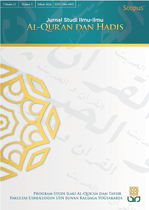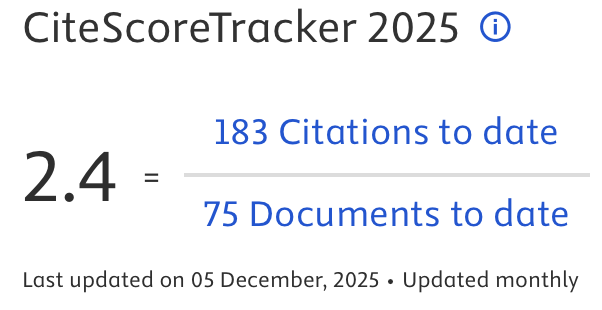The Reception of Hamka's Tafsir Al-Azhar within Social Religious Issues in the Malay World
DOI:
https://doi.org/10.14421/qh.v25i2.5406Keywords:
Reception, Hamka’s Interpretation, Social Religious Issues, Tafsir Al-Azhar, The Malay WorldAbstract
This study explores the reception and impact of Hamka's Tafsir Al-Azhar across the Malay world, particularly in Indonesia, Malaysia, Brunei Darussalam, and Singapore. Tafsir Al-Azhar, written by the renowned Malay scholar Hamka, is a significant work of Qur'anic exegesis that has influenced Islamic thought in Southeast Asia. By employing a qualitative research method, specifically a case study with phenomenological analysis, this research investigates how Tafsir Al-Azhar has been received, interpreted, and utilized by various Muslim communities in these regions. The study examines the historical context in which Hamka's work was produced, focusing on its dissemination and its pivotal role in addressing socio-religious issues from the mid-20th century to the present day. By applying reception theory, the analysis highlights the dynamic interaction between the text and its readers, revealing how interpretations of Tafsir Al-Azhar have evolved in response to shifting social, political, and cultural landscapes. The research also explores the influence of external religious streams, modernity, and globalization on the Malay Muslim identity, and how these factors have shaped the adaptation and reception of traditional tafsir practices. The findings suggest that while Tafsir Al-Azhar has become a central reference in the religious life of Malay Muslims, its reception varies significantly across different countries. These variations are influenced by local cultural, religious, and political contexts, as well as by Hamka's personal interactions with these communities. This study contributes to a deeper understanding of Qur'anic interpretation in Southeast Asia, emphasizing the importance of contextualizing tafsir to address the diverse needs and challenges of Muslim communities in the region.
 Abstract viewed: 1551 times
|
Abstract viewed: 1551 times
|
 PDF downloaded = 909 times
PDF downloaded = 909 times
References
A. H. Jhon. “Islam in South-East Asia, Problem of Persfective.” In Reading on Islam in South-East Asia. Singapore: ISEAS, 1985.
Akbar, Nuruddin Al. “Hamka, Zhenghe, and Indonesian Islam.” Journal of Integrative International Relations 4, no. November (2019): 129–154.
Albayrak, Ismail. “The Reception of Toshihiko Izutsu’s Qur’anic Studies in the Muslim World : With Special Reference to Turkish Qur’anic Scholarship.” Journal of Qur’anic Studies 14, no. 1 (2012): 73–106.
Aljunied, Khairudin. Hamka and Islam: Cosmopolitan Reform in the Malay World. Ithaca and London: Corlnell University Press, 2016.
———. In Defense of Guided Reason: HAMKA and The Reconstruction of Southeast Asian Islam. Chicago: The University of Chicago, 2017.
———. “Reorienting Sufism: Hamka and Islamic Mysticism in the Malay World.” Indonesia 101, no. April 2016 (2016): 67–84.
Asna, Lathifatul, and Nasihun Amin. “Hermeneutics of Reception by Hans Robert Jauss: An Alternative Approach Toward Qur’anic Studies.” International Journal Ihya’ ’Ulum al-Din 24, no. 2 (2022): 160–171.
Azhari, Ahmad Husam Bin, Nadia Amira Binti Mohd Akil, Dinie Syazwani Binti Badrul Aidi, Fatin Usyairah Binti Mohd Shah, Sharifah Miza Farhana Binti Said Anuar, and Suriyati Ujang. “The Comparison Between Students of Coeducational Schools and Single-Sex School in Malaysia.” Jurnal Ilmiah Peuradeun 11, no. 3 (September 30, 2023): 831–46.
Dzaljal, Rifma Ghulam, and et al. Ensiklopedia Buya Hamka: Percikan Pemikiran, Penafsiran, Pemahaman Dan Imajinasi Autentik Buya Hamka. Vol. II. Jakarta: Suara Muhammadiyah, 2022.
El-Fikri, Syahruddin. “Penerbit Malaysia Terbitkan Karya Buya Hamka.” News.Republika.Co.Id.
Fahmi, Rizqi Anfanni, Ris’an Rusli, and Amilda Sani. “Digital Nomad Influence on Malay Work Ethics: Exploring Cultural Dynamics.” Jurnal Ilmiah Peuradeun 12, no. 2 (May 30, 2024): 741–62.
Federspiel, Howard M. “An Introduction To Qur’anic Commentaries in Contemporary Southeast Asia.” The Muslim World LXXXI, no. 2 (1991): 149–161.
Feener, R Michael. “Notes toward the History of Qur’anic Exagenesis in Southeast Asia.” Studia Islamika: Indonesian Journal for Islamic Studies 5, no. 3 (1998): 47–76.
Ferdinal, Ferdinal, Maizufri Maizufri, Donny Syofyan, and Edria Sandika. “Local People’s Perception Towards Visitation to Museum Rumah Kelahiran Buya Hamka: An Ungendered Perspective” (2022).
Goldziher, Ignas. Muslim Studies. London: Goerge Allen & Unwin Ltd, n.d.
Gusmian, Islah. Khazanah Tafsir Al-Qur’an Indonesia: Dari Hermeneutika, Wacana Hingga Ideologi. Yogyakarta: Penerbit Salwa, 2003.
———. Khazanah Tafsir Indonesia: Dari Hermeneutika Hingga Ideologi. Cetakan I. Yogyakarta: LKiS, 2013.
Hadler, Jeffrey. “Home, Fatherhood, Succession: Three Generations of Amrullahs in Twentieth-Century Indonesia.” Indonesia 65 (1998): 122.
Halim, MA. “Hamka Dan Tafsir Al-Azhar: Suatu Kajian Kualiti Hadith.” Universiti Sains Malaysia, 2007.
HAMKA. Tafsir Al-Azhar. 4th ed. Vol. 1. Singapura: Pustaka Nasional Pte Ltd, 2001.
Hashim, Rosnani. “Hamka: Intellectual and Social Transformation of the Malay World.” In Reclaiming the Conversation: Islamic Intellectual Tradition in the Malay Archipelago, edited by Rosnani Hashim, 187–205. 1st ed. Kuala Lumpur: The Other Press, 2010.
Herlambang, Saifuddin, and Wendi Parwanto. “Paradigm Shifts in the Interpretation of Heaven Illustration Among Indonesian Mufassirin: A Comparative Analysis of As-Singkili, Hamka, and M. Quraish.” Jurnal Studi Ilmu-ilmu al-Qur’an dan Hadis 24, no. 1 (2023): 181–204.
Jamarudin, Ade, H Asmal May, and Ofa Ch Pudin. “The Prospect of Human in The Exegetical Work: A Study of Buya Hamka’s Tafsir Al-Azhar.” Ulumuna: Journal of Islamic Studies 23, no. 1 (2019): 24–47.
Jauss, Hans Robert. Toward an Aesthetic of Reception. Translated by Hans Robert. Vol. 2. Minneapolis: The University of Minnesota Press, 1982.
Jauss, Hans Robert, and Elizabeth Benzinger. “Literary History as a Challenge to Literary Theory.” New Literary History 2, no. 1 (1970): 7.
Kholid, Abd, Abu Bakar, Muktafi, and Mukhammad Zamzami. “Rereading the Indonesian Interpretation of the Qur’an on Awliya’: The Cases of Hamka and m. Quraish Shihab.” Qudus International Journal of Islamic Studies 9, no. 1 (2021): 37–72.
Laffan, Michael. “Straight from Mecca: Medan, Hamka, and the Coming of Islam to Indonesia.” The Postcolonial Moment in South and Southeast Asia (2019).
Lukman, Fadhli. The Official Indonesian Qur’ān Translation: The History and Politics of Al-Qur’an Dan Terjemahnya. OpenBook Publishers, 2022.
Mish, Frederick C. The Meriam-Webster Dictionary. Massachusetts: Merriam-Webster Inc, 2004.
Moussay, Gérard. “Une Grande Figure de l’Islam Indonésien : Buya Hamka.” Archipel 32, no. 1 (1986): 87–111.
Munawan, M. “A Critical Discourse Analysis Dalam Kajian Tafsir AlQur’an: Studi Tafsir Al-Azhar Karya Hamka.” TAJDID 25, no. 2 (August 21, 2018): 155.
Mustafid, Mustafid, Kemas Muhammad Gemilang, Firman Surya Putra, Azzuhri Al Bajuri, and Mawardi Mawardi. “Alternative Legal Strategies and Ninik Mamak Authority: Dual Administration of Malay Marriage in Koto Kampar Hulu, Riau.” Journal of Islamic Law 5, no. 1 (January 29, 2024): 1–18.
Nadhiroh, Wardatun, and Wardani. “The Dynamics of Qur’anic Text and Translation in Banjar Ulema’s Works.” Jurnal Studi Ilmu-ilmu al-Qur’an dan Hadis 24, no. 2 (2023): 205–230.
Nurtawab, Ervan. “Haji Abdul Malik Karim Amrullah, or Buya Hamka, or Hamka.” Handbook of Qur’anic Hermeneutics 4 (2023): 325–333.
———. “Qur’anic Readings and Malay Translations in 18th-Century Banten Qur’ans A.51 and W.277.” Indonesia and the Malay World 48, no. 141 (2020): 169–189.
———. “Qurʾanic Translations in Malay, Javanese and Sundanese A Commentary or Substitution?” In The Qur’ān in the Malay-Indonesian World: Context and Interpretation, 39–57. London: Taylor and Francis, 2016.
———. “The Problems of Translation in Turjuman Al-Mustafid: A Study of Theological and Eschatological Aspects.” Studia Islamika: Indonesian Journal for Islamic Studies 18, no. 1 (2011): 33–60.
Osman, Khazri, Fariza Md Sham, Amiza Khusyri, and Abdul Ghafar Don. “Expert Consensus on Educational Concepts According to Hamka and Its Alignment with Practices in Malaysia.” International Journal of Religion 5, no. 3 (2024): 484–493.
Parris, David. “Reception Theory: Philosophical Hermeneutics, Literary Theory, and Biblical Interpretation.” University of Nottingham, 1999.
Pitaloka, Dyah Ayu. “Buku Karya Buya Hamka Diminati Penerbit Negeri Jiran.” Jatimnet.Com.
Rafiq, Ahmad. “Living Qur’an: Its Texts and Practices in the Functions of the Scripture Living Qur’an: Teks Dan Praktik Dalam Fungsi Kitab Suci.” Jurnal Studi Ilmu-Ilmu al-Qur’an dan Hadis 22, no. 2 (2021): 2548–4737.
———. “The Reception of the Qur’an in Indonesia: A Case Study of the Place of the Qur’an in a Non Arabic Speaking Community.” Temple University, 2014.
Riddell, Peter. “The Use of Arabic Commentaries on the Qur’an in the Early Islamic Period in South-East Asia: Report on Work in Progress.” Indonesia Circle. School of Oriental & African Studies. Newsletter 18, no. 51 (1990): 3–19.
Rippin, Andrew. “The Reception of Euro-American Scholarship on the Qur’an and Tafsīr : An Overview.” Journal of Qur’anic Studies 14, no. 1 (2018): 1–8.
Risnal, Muhammad Irfan. “Ad-Dakhil Fiy Tafsir Al-Azhar Limufassir Andunisi Buya Hamka.” Universitas Al-Azhar Kairo Mesir, 2015.
Rush, James R. Adicerita Hamka: Visi Islam Sang Penulis Besar Untuk Indonesia Modern. Translated by Zia Anshor. 2nd ed. Jakarta: Gramedia Pustaka Utama, 2018.
Ruysdah, Syarifah. “Kajian Kualitas Hadis Dalam Tafsir Al-Azhar.” Ushuluna : Jurnal Ilmu Ushuluddin. Universitas Islam Negeri Syarif Hidayatullah Jakarta, 2021.
Said, Hasani Ahmad. “Hasani Ahmad Said , Mengenal Tafsir Nusantara: Melacak Mata Rantai Tafsir Dari Indonesia | 205.” Refleksi 16, no. 2 (2017): 205–231.
Setiawan, Agus. “Anggota DPR Di Malaysia Dirikan Rumah Pustaka Buya Hamka - ANTARA News.” Edited by Monalisa. Antaranews.Com.
Sirry, Mun’im. “What’s Modern about Modern Tafsir? A Closer Look at Hamka’s Tafsir Al-Azhar.” In The Qur`an in the Malay-Indonesian World, edited by Majid Daneshgar, Peter G. Riddell, and Andrew Rippin. New York: Routledge, 2016.
Spredley, James P. Metodologi Etnografi. Translated by M. Zulfa Elizabeth. Yogyakarta: Tiara Wacana Yogya, 1997.
Sugiarto, Fitrah, M. Nurwathani Janhari, and Husnul Hotimah. “Penafsiran Tentang Jilbab Dalam Al-Qur’an Surah Al-Ahzab [33] Ayat 59 Menurut Buya Hamka Pada Tafsir Al-Azhar.” Madinah: Jurnal Studi Islam 7, no. 1 (2020): 118–128.
Taum, Yoseph Yapi. Pengantar Teori Sastra. 1st ed. Flores: Nusa Indah, 1997.
W. Fogg, Kevin. “Hamka’s Doctoral Address at Al-Azhar: The Influence of Muhammad Abduh in Indonesia.” Afkaruna 11, no. 2 (2015).
Yusoff, Zulkifli Mohd. “Pemimpin Menurut Pandangan HAMKA: Satu Tinjauan Dalam Tafsir Al-Azhar (Leadership According to HAMKA: A Review on Tafsir Al-Azhar).” Jurnal al-Tamaddun Bil 8, no. 1 (2013): 17–38.
Zulkarnaini, Zulfikri. “Feminist Exegesis in Hamka’s Tafsir Al-Azhar.” Jurnal Studi Ilmu-ilmu Al-Qur’an dan Hadis 22, no. 2 (July 30, 2021): 409.
Downloads
Published
How to Cite
Issue
Section
License
Copyright (c) 2024 Syafwan Rozi, Nurlizam, M. Zubir

This work is licensed under a Creative Commons Attribution-NonCommercial-NoDerivatives 4.0 International License.
Publishing your paper with Jurnal Studi Ilmu-ilmu al-Qur'an dan Hadis means that the author or authors retain the copyright in the paper. Jurnal Studi Ilmu-ilmu al-Qur'an dan Hadis uses license CC-BY-NC-ND or an equivalent license as the optimal license for the publication, distribution, use, and reuse of scholarly works. This license permits anyone to copy and redistribute the material in any medium or format and must give appropriate credit, provide a link to the license, and indicate if changes were made. If you remix, translate, transform or build upon the material you may use it for private use only and not for distribution. Jurnal Studi Ilmu-ilmu al-Qur'an dan Hadis granted an exclusive non-commercial reuse license by the author(s), but the author(s) are able to put the paper onto a website, distribute it to colleagues, give it to students, use it in your thesis, etc, so long as the use is not directed at a commercial advantage or toward private monetary gain. The author(s) can reuse the figures and tables and other information contained in their paper published by Jurnal Studi Ilmu-ilmu al-Qur'an dan Hadis in future papers or work without having to ask anyone for permission, provided that the figures, tables, or other information that is included in the new paper or work properly references the published paper as the source of the figures, tables or other information, and the new paper or work is not direct at a private monetary gain or commercial advantage.
Jurnal Studi Ilmu-ilmu al-Qur'an dan Hadis journal Open Acces articles are distrubuted under the Creative Commons Attribution-NonCommercial-NoDerivatives 4.0 International (CC BY-NC-ND 4.0). Article can be read, copy and redistribute the material ini any medium or format under the following conditions:
Attribution — You must give appropriate credit, provide a link to the license, and indicate if changes were made. You may do so in any reasonable manner, but not in any way that suggests the licensor endorses you or your use.
NonCommercial — You may not use the material for commercial purposes.
NoDerivatives — If you remix, transform, or build upon the material, you may not distribute the modified material.










